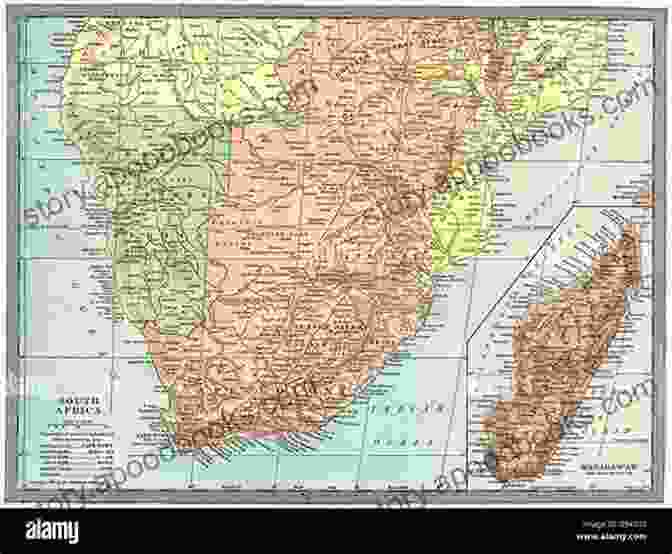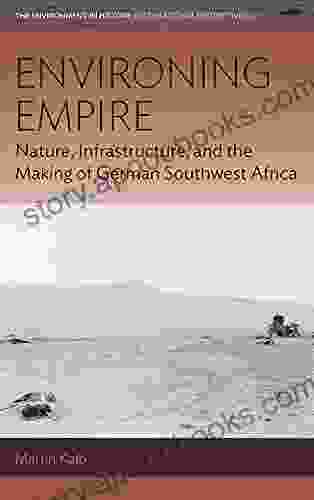Nature Infrastructure and the Making of German Southwest Africa: Environment in Imperial Imagination

##
##
5 out of 5
| Language | : | English |
| File size | : | 989 KB |
| Text-to-Speech | : | Enabled |
| Enhanced typesetting | : | Enabled |
| Word Wise | : | Enabled |
| Print length | : | 351 pages |
| Lending | : | Enabled |
Unveiling the Role of Nature in Colonial Landscape Transformation
###
In the annals of colonial history, the role of infrastructure often takes center stage, overshadowed by the dramatic narratives of conquest, exploitation, and resistance. Yet, in the case of German Southwest Africa (present-day Namibia),a different story unfolds—one where nature itself became a vital cog in the colonial machine, shaping the destiny of both land and people.
"Nature Infrastructure and the Making of German Southwest Africa: Environment in Imperial Imagination" delves into this captivating tale, revealing the intricate relationship between nature and the German colonial enterprise.

###
Nature as Infrastructure
The German colonizers approached Southwest Africa with an ambitious plan to transform the perceived wilderness into a productive colony. Key to this endeavor was the creation of infrastructure—not just physical structures like railroads and harbors but also the harnessing of natural resources to serve colonial needs.
Rivers were dammed to generate hydroelectric power and provide irrigation for agriculture. Vast tracts of land were cleared for cattle ranching, introducing a new economic activity to the region. Forests were exploited for timber, fueling the construction boom in German cities across the colony.
In this way, nature became an integral part of the colonial infrastructure, its resources harnessed to support economic growth and extend German control over the territory.
###
The Imperial Imagination
The German colonizers' vision for Southwest Africa was shaped by the prevailing imperial imagination of the time. Nature was seen as a resource to be exploited, a challenge to be overcome, and a stage on which to demonstrate German superiority.
The colonial narrative portrayed the transformation of the African environment as a civilizing mission, bringing progress and Free Download to a perceived wilderness. By taming the rivers, felling the forests, and introducing European agricultural practices, the Germans aimed to create a colonial landscape that reflected their own values and aspirations.
###
Environmental Impacts and Indigenous Resistance
The large-scale infrastructural projects and resource exploitation had profound impacts on the African environment. Dams disrupted river ecosystems, deforestation led to soil erosion, and the of alien species upset the delicate balance of local flora and fauna.
Indigenous communities, who had lived in harmony with the land for centuries, saw their way of life disrupted by the colonial transformation. Their traditional grazing grounds were taken over by European ranchers, their water sources diverted for irrigation, and their sacred sites desecrated in the name of progress.
Resistance to colonial encroachment took various forms, from armed uprisings to more subtle acts of non-cooperation. The Herero and Namaqua peoples, in particular, waged a fierce war against German forces in the early 1900s, a conflict that culminated in the first genocide of the 20th century.
###
Legacy and Lessons
The legacy of German colonialism in Southwest Africa is a complex and contested one. The infrastructural developments initiated by the colonizers laid the foundation for Namibia's modern economy, but they came at a great environmental and social cost.
"Nature Infrastructure and the Making of German Southwest Africa" provides a nuanced account of this history, shedding light on the interplay between nature, infrastructure, and imperialism. It offers valuable lessons for understanding the lasting impacts of colonialism and the importance of sustainable development in the 21st century.
###
Reviews and Accolades
"A groundbreaking work that unveils the hidden history of nature as infrastructure in colonial Namibia. A must-read for anyone interested in environmental history, colonialism, and the making of modern Africa."
- Professor Adam Kuper, University of London
"A compelling and thought-provoking exploration of the complex relationship between nature and colonialism. Highly recommended for scholars and anyone concerned with the environmental legacy of imperialism."
- Professor Nancy Jacobs, University of California, Berkeley
###
Call to Action
Embark on a journey into the heart of colonial history and its lasting environmental impacts. Free Download your copy of "Nature Infrastructure and the Making of German Southwest Africa" today and delve into a captivating tale that will enrich your understanding of the past and inspire your vision for a sustainable future.
Available now in print and e-book formats.
Free Download Now
5 out of 5
| Language | : | English |
| File size | : | 989 KB |
| Text-to-Speech | : | Enabled |
| Enhanced typesetting | : | Enabled |
| Word Wise | : | Enabled |
| Print length | : | 351 pages |
| Lending | : | Enabled |
Do you want to contribute by writing guest posts on this blog?
Please contact us and send us a resume of previous articles that you have written.
 Book
Book Novel
Novel Page
Page Chapter
Chapter Text
Text Story
Story Genre
Genre Reader
Reader Library
Library Paperback
Paperback E-book
E-book Magazine
Magazine Newspaper
Newspaper Paragraph
Paragraph Sentence
Sentence Bookmark
Bookmark Shelf
Shelf Glossary
Glossary Bibliography
Bibliography Foreword
Foreword Preface
Preface Synopsis
Synopsis Annotation
Annotation Footnote
Footnote Manuscript
Manuscript Scroll
Scroll Codex
Codex Tome
Tome Bestseller
Bestseller Classics
Classics Library card
Library card Narrative
Narrative Biography
Biography Autobiography
Autobiography Memoir
Memoir Reference
Reference Encyclopedia
Encyclopedia Oliver Gaspirtz
Oliver Gaspirtz Nan Mcdonald
Nan Mcdonald Michael L Kent
Michael L Kent Michael Kinnett
Michael Kinnett Russ Marion
Russ Marion Madeline Ffitch
Madeline Ffitch Scott Skinner Thompson
Scott Skinner Thompson Osho
Osho Rob Winters
Rob Winters Liza Charlesworth
Liza Charlesworth Renata Riva
Renata Riva William Parrett
William Parrett Stephen C Hill
Stephen C Hill Prudence L Carter
Prudence L Carter Lilia Ghazvini
Lilia Ghazvini Steven M Friedson
Steven M Friedson M E Thomas
M E Thomas Susan Strauss
Susan Strauss Max Krochmal
Max Krochmal Tony Barrell
Tony Barrell
Light bulbAdvertise smarter! Our strategic ad space ensures maximum exposure. Reserve your spot today!

 Eugene ScottUnlock the Rhythmic Power of the Tambourine: Discover Our Comprehensive Video...
Eugene ScottUnlock the Rhythmic Power of the Tambourine: Discover Our Comprehensive Video... Craig CarterFollow ·4.1k
Craig CarterFollow ·4.1k Thomas PynchonFollow ·8.2k
Thomas PynchonFollow ·8.2k Jason ReedFollow ·12.7k
Jason ReedFollow ·12.7k Nikolai GogolFollow ·12k
Nikolai GogolFollow ·12k Cooper BellFollow ·16.7k
Cooper BellFollow ·16.7k Jeffery BellFollow ·2.8k
Jeffery BellFollow ·2.8k Wade CoxFollow ·4.4k
Wade CoxFollow ·4.4k Jan MitchellFollow ·7.6k
Jan MitchellFollow ·7.6k

 Jorge Luis Borges
Jorge Luis BorgesUnlock Your Inner Musician: The Ultimate Guide to...
Embark on a Musical...

 Carlos Drummond
Carlos DrummondQuick Reference Guide To Percussion Instruments And How...
Unleash your inner rhythm with...

 Roberto Bolaño
Roberto BolañoUnlock Your Guitar Potential: The Ultimate Guitar Mastery...
Are you ready...

 Fred Foster
Fred FosterLooking for Lady Dee: A Punk Rock Mystery
By [Author's Name] Looking for Lady Dee is...

 Jacques Bell
Jacques BellJourney into the Mystical Realm of "Heaven Polly Alice...
In the tapestry of literature, where...

 Julio Ramón Ribeyro
Julio Ramón RibeyroSixty Years of Hits: A Musical Journey Through Time
Music has the...
5 out of 5
| Language | : | English |
| File size | : | 989 KB |
| Text-to-Speech | : | Enabled |
| Enhanced typesetting | : | Enabled |
| Word Wise | : | Enabled |
| Print length | : | 351 pages |
| Lending | : | Enabled |










